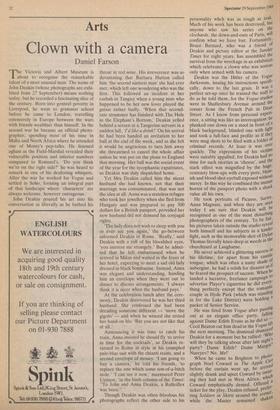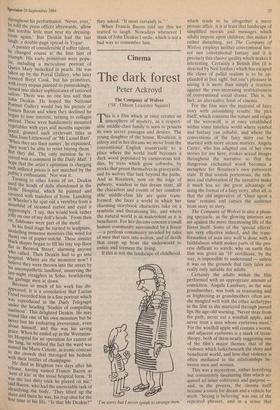Arts
Clown with a camera
Daniel Fuson
The Victoria and Albert Museum is about to recognise the remarkable talent of a most unusual man. The name of John Deakin (whose photographs are exhi- bited from 27 September) means nothing today, but he recorded a fascinating slice of the century. Born into genteel poverty in Liverpool, he went to grammar school before he came to London, travelling extensively in Europe between the wars with friends wealthier than himself. In the second war he became an official photo- grapher. spending most of his time in Malta and North Africa where he attended one of Monty's pep-talks. He listened aghast as the Field-Marshal revealed their vulnerable position and inferior numbers compared to Rommel's. 'Do you think we're on the right side?' he was heard to remark in one of his deafening whispers. After the war he worked for Vogue and settled in Soho, forming an integral part of that landscape where 'characters' are always welcome, however outrageous.
John Deakin poured his art into his conversation as liberally as he bathed his throat in red wine. His irreverence was so devastating that Barbara Hutton called him 'the second nastiest man' she had ever met, which left one wondering who was the first. This followed an incident at her casbah in Tangier when a young man who happened to be her new lover played the guitar rather badly. 'When that second- rate strummer has finished with The Hole in the Elephant's Bottom,' Deakin yelled behind a screen at a Tangerine servant in a sudden lull, 'I'd like a drink!' On his arrival he had been handed an invitation to her ball at the end of the week, and as she felt it would be ungracious to turn him away she threatened to cancel the whole affair unless he was put on the plane to England that morning. Her ball was the social event of the year for the sycophantic expatriates, so Deakin was duly dispatched home.
Yet Mrs Deakin called him the nicest husband she had known, not that their marriage was consummated, that was not the idea at all. Anna was a stateless refugee who took her jewellery when she fled from Hungary and was prepared to pay 500 dollars for a British passport, provided her new husband did not demand his conjugal rights.
'The lady does not wish to sleep with you or ever see you again,' the go-between informed Deakin in Rome. 'Really,' said Deakin with a roll of his bloodshot eyes, 'you interest me strangely.' But he admit- ted that he felt embarrassed when he arrived in Milan and waited in the foyer of her hotel, expecting to meet a sad old lady dressed in black bombazine. Instead, Anna was elegant and understanding, handing him an envelope when they went out to dinner to discuss arrangements: 'I always think it is nicer when the husband pays.'
At the celebration lunch after the cere- mony, Deakin discovered he was her third husband. She confessed she had been dreading someone different — 'more the gigolo' — and when he winced she rested her hand on his: 'But you are not like that at all.'
Announcing it was time to catch his train, Anna insisted he should fly 'to arrive in time for the cocktails', so Deakin re- turned to Rome in style in his crumpled pale-blue suit with the chianti stains, and a second envelope of money. 'I am going to buy a camera,' he told his friends, 'to replace the one which some son-of-a-bitch stole.' I can see it now,' murmured Peter Ustinov, 'in the birth column of the Times: "To John and Anna Deakin, a Rolleiflex was born." ' Though Deakin was often frivolous his photographs reflect the other side to his
Spectator 29 September 1984 personality whch was as tough as teak. Much of his work has been destroyed, but anyone who saw his series on the clochards, the down-and-outs of Paris, will confirm what we have lost. Fortunately, Bruce Bernard, who was a friend of Deakin and picture editor at the Sunday Times for eight years, has assembled the survival from the wreckage in an exhibition which celebrates a clown who was serious only when armed with his camera. Deakin was the Hitler of the Vogue darkroom, issuing his instructions specifi- cally, down to the last grain. It was perfect set-up once he trained the staff to do as he told them, for the Vogue studios were in Shaftesbury Avenue around the corner from the French Pub in Dean Street. As I know from personal experi- ence, a sitting was like an interrogation: he plunked one down on a stool in front of a black background, blinded one with light and took a full-face and profile as if they were mug shots to be filed with a folder of criminal records. At least it was over quickly. The expressions of his victims were suitably appalled, for Deakin had ne time for such niceties as 'cheese', and the stark effect was magnified by the huge, contrasty blow-ups with every pore, blem- ish and blood-shot eyeball exposed without mercy. In this way he combined the instant horror of the passport photo with a shock value all his own. He took portraits of Picasso, Sartre, Anna Magnani, and when they are seen today I am sure that Deakin will be recognised as one of the most disturbing photographers of the century. To be fair: his pictures taken outside the studio reveal both himself and his subjects in a kinder light, such as the memorable shot of Dylan Thomas literally knee-deep in weeds in the churchyard at Laugharne. He never achieved a glittering success in his lifetime, for apart from his caustic. tongue, which was often a nasty shade Of, aubergine, he had a relish for disaster as it he feared the prospect of success. When he landed a lucrative, freelance campaign to advertise Player's cigarettes he did every' thing perfectly except that the romantic couple in Hyde Park (which was standing in for the Lake District) were holding 3 packet of Senior Service. He was fired from Vogue after passing out at an elegant office party, falling against Dame Edith Evans as he did so Cecil Beaton cut him dead in the Vogue Itft . the next morning. The dismissal dismayed Deakin for a moment but he rallied: `Wh° will they be talking about after last night'9 party? Dame Edith? Dame Marg°t'
Nureyev? No. Me!' •
When he came to Brighton to photo- graph Noel Coward in The Apple Cart before the curtain went up, he arrived slightly drunk and upset Coward by insi,stt; ing they had met in West Africa, whic,, a Coward emphatically denied. Offered ticket for the play, Deakin refused, prefer- ring Soldiers in Skirts around the corner_, while the Master remained shaken throughout his performance. 'Never, ever,' he told the press officer afterwards, 'allow that terrible little man near my dressing- room again.' But Deakin had the last laugh: a double-page spread in Vogue. A painter of considerable if softer talent, he changed course at the first hint of triumph. His early primitives were popu- lar, including a meticulous portrait of Queen Mary bedecked in pearls. He was taken up by the Portal Gallery, who later boosted Beryl Cook, but his primitives, with every sequin painted so painstakingly, turned into slicker sophisticates of tattooed sailors. There was no one less naif than John Deakin. He hoped the National Portrait Gallery would buy his picture of Francis Bacon and when they declined he began to lose interest, turning to collages instead. These were handsomely mounted vegetables with eyes and mouths superim- posed, granted such irrelevant titles as `Miss Joan Littlewood' or 'Mr Lionel Bart'. When they see their names', he explained, they won't be able to resist buying them.' But they did. The only mention he re- ceived was a comment in the Daily Mail: 'I hope that the artist's optimism in charging such inflated prices is not matched by the public's enthusiasm.' Nor was it.
Turning to other forms of art, Deakin used the heads of dolls abandoned in the Dolls' Hospital, which he painted and covered with transfers of ferns. Lunching at Wheeler's he spat out a vertebra from a mouthful of steamed turbot and eyed it aPprovingly. 'I say, this would look rather jolly on one of my doll's heads.' From then on, fishbones were part of the motif. In his final stage he turned to sculpture, modelling immense monsters (his word for them) out of papier-mâché. These sinister black shapes began to fill his tiny top-floor flat in Berwick Street, alarming anyone who called. Then Deakin had to go into hospital. Where are the monsters now? I believe they were thrown into the street by his unsympathetic landlord, unnerving the late-night stragglers in Soho, bewildering the garbage men at dawn.
Because so much of his work has dis- appeared, it is a consolation that Lucian Freud recorded him in a fine portrait which was reproduced in the Daily Telegraph under the heading 'Studies of compelling nastiness'. This delighted Deakin. He may sound like one of his own monsters but he never lost his endearing irreverence, even about himself, and this was his saving grace. When he ended up in the Westmins- ter Hospital for an operation for cancer of the lung, he relished the fact the ward was named the Marie Celeste, in ironic contrast to the crowds that thronged his bedside with their bottles of champagne.
He died in Brighton two days after his release, having named Francis Bacon as next of kin' in the usual hospital form. 'It was the last dirty trick he played. on me,' said Bacon, who had the unenviable task of identifying the body. 'They lifted up the sheet and there he was, his trap shut for the first time in his life. "Is that Mr Deakin?" they asked. "It most certainly is." ' When Francis Bacon told me this we started to laugh. Nowadays whenever I think of John Deakin I smile, which is not a bad way to remember him.















































 Previous page
Previous page